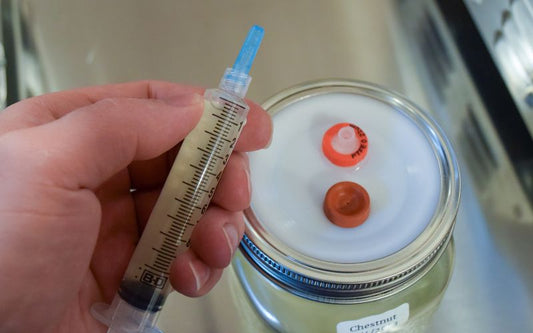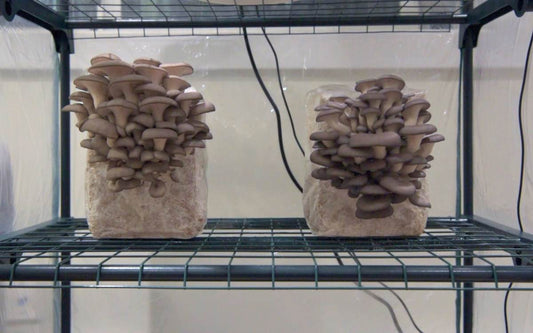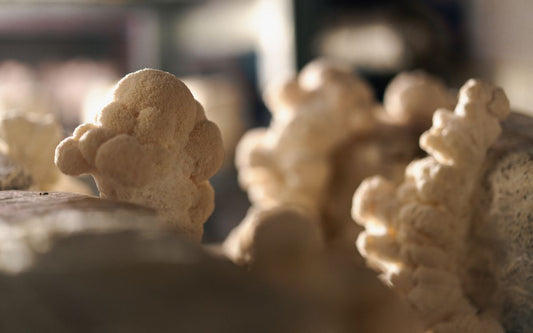If you're looking to cultivate mushrooms in Canada, a mushroom growing kit is the perfect way to start.
Mushroom kits make it easy for anyone, regardless of experience, to grow mushrooms.
In this guide, we'll teach you everything you need to know about mushroom kits—from choosing the right kind to special considerations for growing in Canada.
What is a mushroom growing kit?
Mushroom growing kits contain everything you need to grow mushrooms at home.
A typical mushroom kit contains:
- 1x fruiting block
- 1x spray bottle
Some mushroom kits also include a humidity tent.
Let's go over each item so you can understand what they are.
Fruiting block
A clear bag containing a growing medium, usually sawdust, that is inoculated with mycelium.
(Mycelium is like the mushroom's root system, absorbing nutrients and water from the growing medium.)
As the name implies, mushrooms will fruit from the fruiting block.

Spray bottle
To produce mushrooms, a fruiting block needs an environment with high humidity.
To create high humidity, you need to mist the area around your fruiting block with a spray bottle.

Humidity tent
A clear tent with ventilation holes to cover your fruiting block, which will retain the humidity you create by misting.
While you can grow most mushroom kit species without one, a humidity tent can increase the success and yield of your grow.

How do I use a mushroom kit?
Now that you know what's in a mushroom kit, let's explain how to use one in more detail.
While instructions may vary slightly in different kits, the steps outlined below cover the essentials.
Prepare the fruiting block
Cut an "X" into the front of the fruiting block with a clean knife or scissors (dirty equipment can lead to contamination).
Oxygen will signal to the mycelium that it's time to start fruiting mushrooms from the "X."
Important: leave the block in the plastic bag! The bag helps keep the block hydrated and humid, which is crucial for fruiting.
Some kits, especially mass-produced ones, require you to hydrate the fruiting block after cutting the "X."
This typically involves soaking the block in a bowl of water for twelve hours.
After cutting open your block (and hydrating if required), place it on a plate or tray to catch any dripping water that will occur when misting.
Find an area to grow
Mushrooms, unlike plants, don't convert sun energy into food.
However, your block still needs a few hours of indirect sunlight each day to fruit.
Place your block somewhere in your home with enough light to read a book.
If you're using a humidity tent, place it over the block.
Different mushrooms grow best in different temperatures, but room temperature works great for most mushroom kits.

Mist and fruit
Next, you need to fruit your mushrooms.
To do this, create a humid environment by misting around the block with your spray bottle.
If you're using a humidity tent, mist the inside walls of the tent instead.
Depending on the species, you'll see baby mushrooms fruiting from your block in a few days to a few weeks!
Harvest
When your mushrooms are fully grown, it's time to harvest.
If you wait too long, they will release a heavy dusting of spores.
Your kit will provide instructions on when the best time to harvest is.
If you're growing oyster mushrooms, a common species for first-time grows, harvest when the caps begin to curl up.
And that's it!
If you can follow the instructions above, you can grow mushrooms.
What kind of mushroom kit should I start with?
Two species are especially common in grow kits: oyster mushrooms and lion's mane.
Oysters are probably the easiest to grow.
They double in size each day, usually reaching full size in less than a week, and are generally forgiving in nature (they also taste amazing).

While lion's mane requires a little more effort, it's well worth it.
They have a unique taste and texture, and they also have a long list of medicinal benefits.

You can't go wrong with oysters or lion's mane for your first grow.
Do mushroom grow kits keep growing?
Most grow kit companies promise at least one harvest (also called a "flush") per kit.
Though, if you keep the block in a humid environment after the first harvest, there's a good chance you'll get a second or maybe even a third one.
Considerations for growing mushrooms in Canada
Mushrooms are sensitive to temperature and humidity, which can be a challenge in certain Canadian climates.
If you live in a dry climate, consider searching for a kit with a humidity tent so you can better retain humidity.
If you're growing in winter and your house gets cold at night, choose a cold weather mushroom (blue oysters, for example) instead of a warm temperature one (like pink oysters).

Where can I buy a mushroom grow kit in Canada?
In Canada, the easiest way to purchase a grow kit is through an online store that sells them.
Long travel times can be hard on mycelium, so consider buying from a Canadian seller instead of an international one.
You might also find grow kits at your local farmer's market and in some gardening supply stores.
Are mushroom grow kits worth it?
If you're looking for an easy way to grow mushrooms, a kit is a great option.
But beware: they're known to ignite lifelong passions for fungi in those who try them!
If you're interested in growing your own mushrooms, we highly recommend picking up a mushroom grow kit.
Happy growing!

Spenser Smith
I am passionate about mushrooms. My number one goal: help you grow mushrooms in your home!





2 comments
It’s always best to buy mushroom kits from your own country! (Or better yet, the same province/state.)
bought a mushroom kit fron China. 2 months after I planted them no sign of mushrooms.
I planted them in chicken manure from a hardware store.